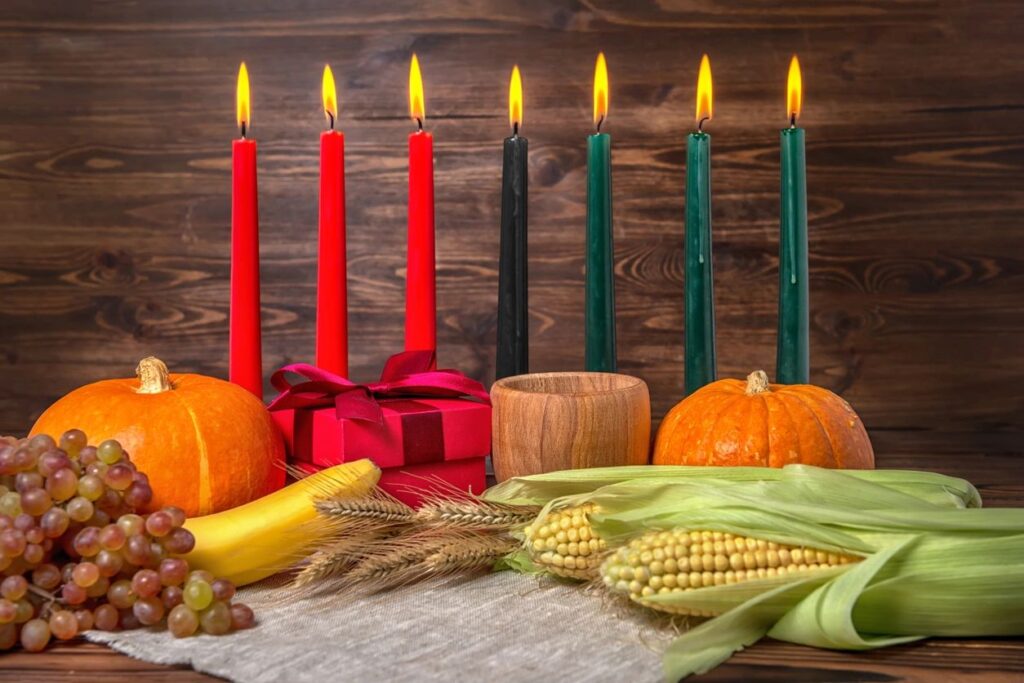
What Is Kwanzaa?
Unlike Christmas, Ramadan, or Hanukkah, Kwanzaa is unaffiliated with a major religion. Kwanzaa is a celebration that has its roots in the Black Nationalist movement of the 1960s and was established as a means to help African Americans reconnect with their African cultural and historical heritage by uniting in meditation and study of African traditions and Nguzo Saba, the “seven principles of African Heritage”
It is observed from December 26th to January 1st annually. Former U.S. presidents Bill Clinton and George W. Bush recognized the day while in office. But Kwanzaa has its share of critics, despite its mainstream status. Now, fully recognized in mainstream America, Kwanzaa is widely celebrated. The U.S. Postal Service debuted its first Kwanzaa stamp in 1997, releasing a second commemorative stamp in 2004.
The name Kwanzaa was derived from the Swahili term, “matunda ya kwanza,” which means “first-fruits,” Kwanzaa is based on African harvest celebrations such as the seven-day Umkhost of Zululand.
According to the official Kwanzaa website, “Kwanzaa was created out of the philosophy of Kawaida, which is a cultural nationalist philosophy that argues that the key challenge in black people’s lives is the challenge of culture, and that what Africans must do is to discover and bring forth the best of their culture, both ancient and current, and use it as a foundation to bring into being models of human excellence and possibilities to enrich and expand our lives.”
Just as many African harvest celebrations run for seven days, Kwanzaa has seven principles known as the Nguzo Saba. They are: umoja (unity); kujichagulia (self-determination); ujima (collective work and responsibility); ujamaa (cooperative economics); nia (purpose); kuumba (creativity); and imani (faith).
Celebrating Kwanzaa
During Kwanzaa celebrations, a mkeka (straw mat) rests on a table covered by kente cloth, or another African fabric. On top of the mkeka sits a kinara (candleholder) where the mishumaa saba (seven candles) go. The colors of Kwanzaa are black for the people, red for their struggle, and green for the future and hope that comes from their struggle, according to the official Kwanzaa website.
Supplemental representations include a Nguzo Saba poster, the black, red, and green bendera (flag), and African books and artworks – all to represent values and concepts reflective of African culture and contribution to community building and reinforcement. Corn is the primary symbol for both decoration and celebratory dining.
Mazao (crops) and the kikombe cha umoja (the unity cup) for giving shukrani (thanks) to African Ancestors, and Zawadi (gifts). The unity cup is used to pour tambiko (libation) in remembrance of ancestors
Principles and symbols
The seven principles of Kwanzaa comprise Kawaida, a Swahili word meaning “common”. Each of the seven days of Kwanzaa is dedicated to one of the following principles, as follows:
Umoja (Unity): To strive for and to maintain unity in the family, community, nation, and race.
Kujichagulia (Self-Determination): To define and name ourselves, as well as to create and speak for ourselves.
Ujima (Collective Work and Responsibility): To build and maintain our community together and make our brothers’ and sisters’ problems our problems and to solve them together.
Ujamaa (Cooperative Economics): To build and maintain our own stores, shops, and other businesses and to profit from them together.
Nia (Purpose): To make our collective vocation the building and developing of our community in order to restore our people to their traditional greatness.
Kuumba (Creativity): To do always as much as we can, in the way we can, in order to leave our community more beautiful and beneficial than we inherited it.
Imani (Faith): To believe with all our hearts in our people, our parents, our teachers, our leaders, and the righteousness and victory of our struggles.